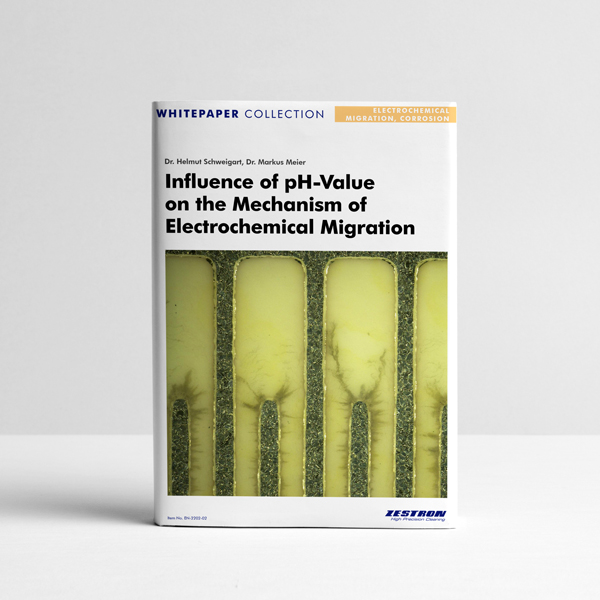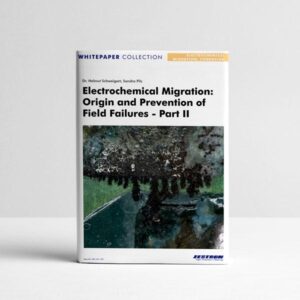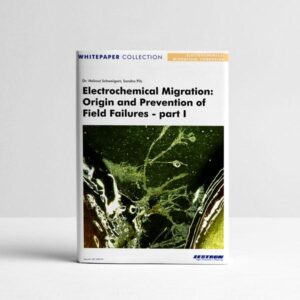Description
[02/2022]
Despite its long history, electrochemical migration is still one of the most frequent causes of failure of electronic assemblies under moisture and condensation loads.
Since the mechanism appears in variants especially at CAF and anodic migration phenomenon, a further deepening of the understanding is helpful to be able to better estimate risks especially in power electronic assemblies. The course of the pH-value development over the individual stages of electrochemical migration was observed via video analyses by using a microscope and correlated with the electrochemical properties of tin.
In the technical paper, the pH value and gas development based on real-time videos of the electrochemical migration and the explanation of the 3 above-mentioned stages based on the chemistry of the silver or the so-called Pourbaix diagram for silver are discussed.
Author
 Dr. Helmut Schweigart
Dr. Helmut Schweigart
Head of Reliability & Surfaces, ZESTRON EUROPE
Dr. Helmut Schweigart obtained his doctorate for research into the reliability of electronic sub-assemblies, and he has been employed at ZESTRON Europe since the early days of the company. He is now Head of Reliability & Surfaces Team. He is also a member of the Board of Management at GfKORR (Gesellschaft für Korrosionsschutz - a company specialising in corrosion inhibitors) as well as an active member of GUS (Gesellschaft für Umweltsimulation - an environmental simulation company) and of the IPC. He has already published numerous technical articles.
 Dr. Markus Meier
Dr. Markus Meier
Senior Technology Analyst, ZESTRON EUROPE
After his study of chemistry at the Technical University Munich, Markus Meier worked among others on the ageing of cement and earned a PhD on the topic crystallization of cement-hydrate-phases under microgravity conditions. He is experienced in the areas interfacial chemistry and surface analytics. He is part of the Reliability & Surfaces Team in which he is responsible for the coordination of research projects as well as the organization of technology coachings. He has already published numerous technical articles.


 Dr. Helmut Schweigart
Head of Reliability & Surfaces, ZESTRON EUROPE
Dr. Helmut Schweigart obtained his doctorate for research into the reliability of electronic sub-assemblies, and he has been employed at ZESTRON Europe since the early days of the company. He is now Head of Reliability & Surfaces Team. He is also a member of the Board of Management at GfKORR (Gesellschaft für Korrosionsschutz - a company specialising in corrosion inhibitors) as well as an active member of GUS (Gesellschaft für Umweltsimulation - an environmental simulation company) and of the IPC. He has already published numerous technical articles.
Dr. Helmut Schweigart
Head of Reliability & Surfaces, ZESTRON EUROPE
Dr. Helmut Schweigart obtained his doctorate for research into the reliability of electronic sub-assemblies, and he has been employed at ZESTRON Europe since the early days of the company. He is now Head of Reliability & Surfaces Team. He is also a member of the Board of Management at GfKORR (Gesellschaft für Korrosionsschutz - a company specialising in corrosion inhibitors) as well as an active member of GUS (Gesellschaft für Umweltsimulation - an environmental simulation company) and of the IPC. He has already published numerous technical articles.
 Dr. Markus Meier
Senior Technology Analyst, ZESTRON EUROPE
After his study of chemistry at the Technical University Munich, Markus Meier worked among others on the ageing of cement and earned a PhD on the topic crystallization of cement-hydrate-phases under microgravity conditions. He is experienced in the areas interfacial chemistry and surface analytics. He is part of the Reliability & Surfaces Team in which he is responsible for the coordination of research projects as well as the organization of technology coachings. He has already published numerous technical articles.
Dr. Markus Meier
Senior Technology Analyst, ZESTRON EUROPE
After his study of chemistry at the Technical University Munich, Markus Meier worked among others on the ageing of cement and earned a PhD on the topic crystallization of cement-hydrate-phases under microgravity conditions. He is experienced in the areas interfacial chemistry and surface analytics. He is part of the Reliability & Surfaces Team in which he is responsible for the coordination of research projects as well as the organization of technology coachings. He has already published numerous technical articles. 


